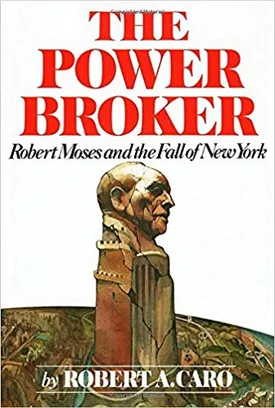The Power Broker: Robert Moses and the Fall of New York by Robert Caro
Robert Caro’s Pulitzer Prize-winning biography The Power Broker: Robert Moses and the Fall of New York chronicles the life of Robert Moses and his efforts to reshape the city of New York. Moses’s ambition and influence led him to become the most monetarily powerful and influential builder in New York City’s history. Caro paints a powerful portrait of Moses’s accomplishments, shortcomings, and legacy, as well as its implications for contemporary architecture, urban life and New York City.
The book begins by recounting Moses' childhood and rise to prominence in New York City. Born into a wealthy family, Moses was able to access opportunities that enabled him to build a powerful career. After completing a degree in engineering from Yale, he secured a series of government positions that would eventually lead him to become the director of most of New York City’s public-works projects. By the 1930s, he had become immensely powerful, making connections with local, state and federal governments.
Yet, Moses did not merely concern himself with the fundaments of big projects. He put inside knowledge to use to gain power, build allies and lobby for jobs, contracts and other favors. Caro explains that,” Moses had a genius for manipulating politicians, mayors and governors, almost dictating to them by force of influence alone”. Consequently, he was able to build an efficient parallel government which granted him extraordinary autonomy and fueled his ambition to create massive public works such as parks, bridges, expressways and housing projects. But despite his tireless work ethic and monumental projects, Moses’s success was tinged with tragedy.
In Caro’s narrative, Moses’s accomplishments are presented as part of a larger critique of urban planning and its effects on the people in cities. For example, Moses envisioned expressways transforming the city, linking its various boroughs, but these projects excluded large segments of the population. As Caro puts it “He was solving the transportation problem for one segment of the city, for the people with cars; but he was creating immense problems— of physical destruction, relocation, and segregation— for those without cars.”
Moses was also responsible for the destruction of neighbourhoods in the name of “slum clearance” projects, often with insufficient promise of new housing. In Caro’s book, Moses’s obsessive drive to achieve tangible results overshadowed his consideration of other priorities, such as providing housing adequate for the poor.
Reception to The Power Broker since its release in 1974 has been mixed. On one hand, it has been praised as one of the most influential works of urban sociology, changing the way we think about public housing, urban planning and development. And, on the other hand, it has drawn criticism for it’s largely negative portrayal of Moses and its oversimplification of complex socio-economic forces.
Ultimately, the lasting contributions of Robert Moses and the stories told in The Power Broker are both essential for any student of urban history. Caro’s book provides vivid insights into the man, his projects and their impacts, as well as how contemporary cities struggle to reconcile the legacy of modernist urban planning. The Power Broker continues to be an invaluable source on the central themes of urbanization, the place of the poor in modern cities and the re-shaping of public space.

